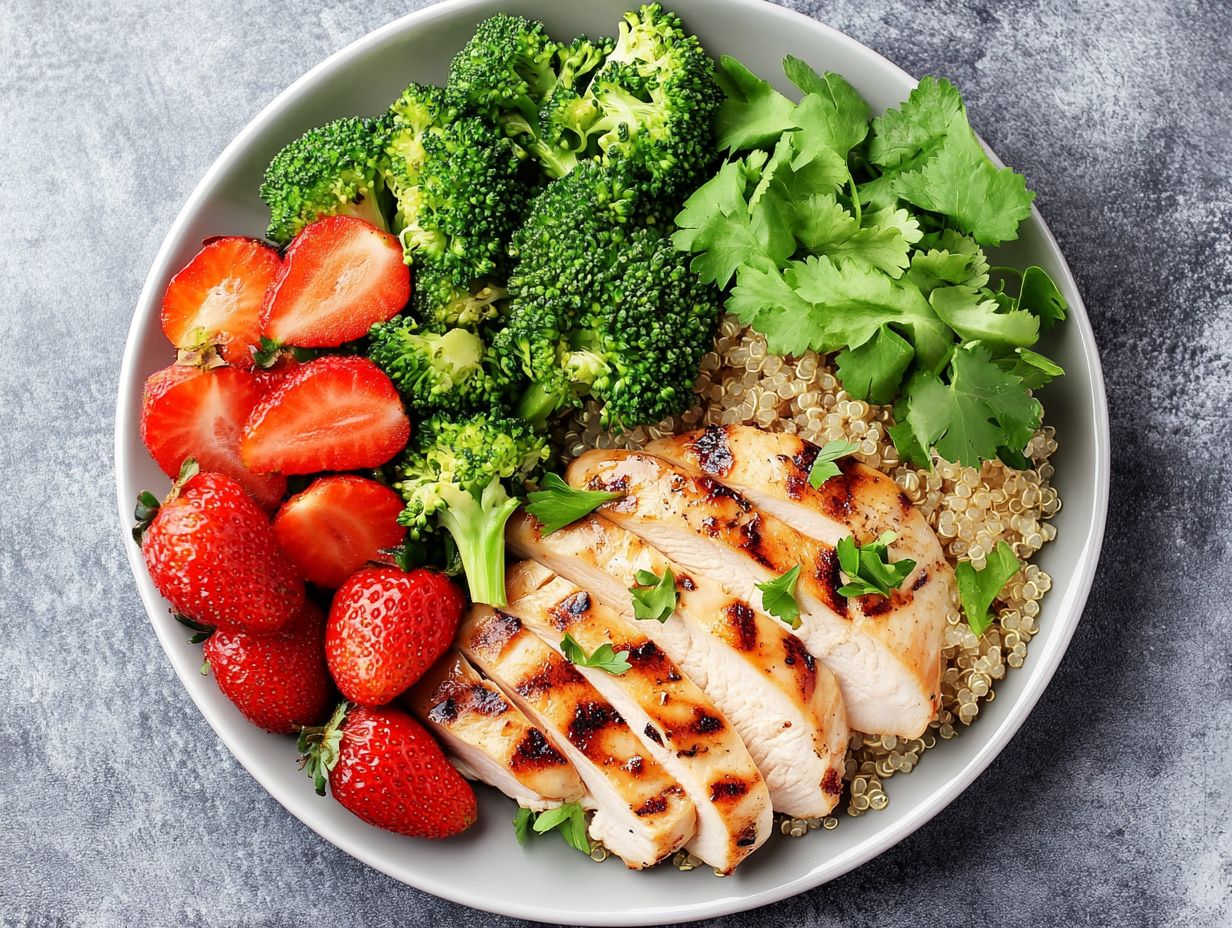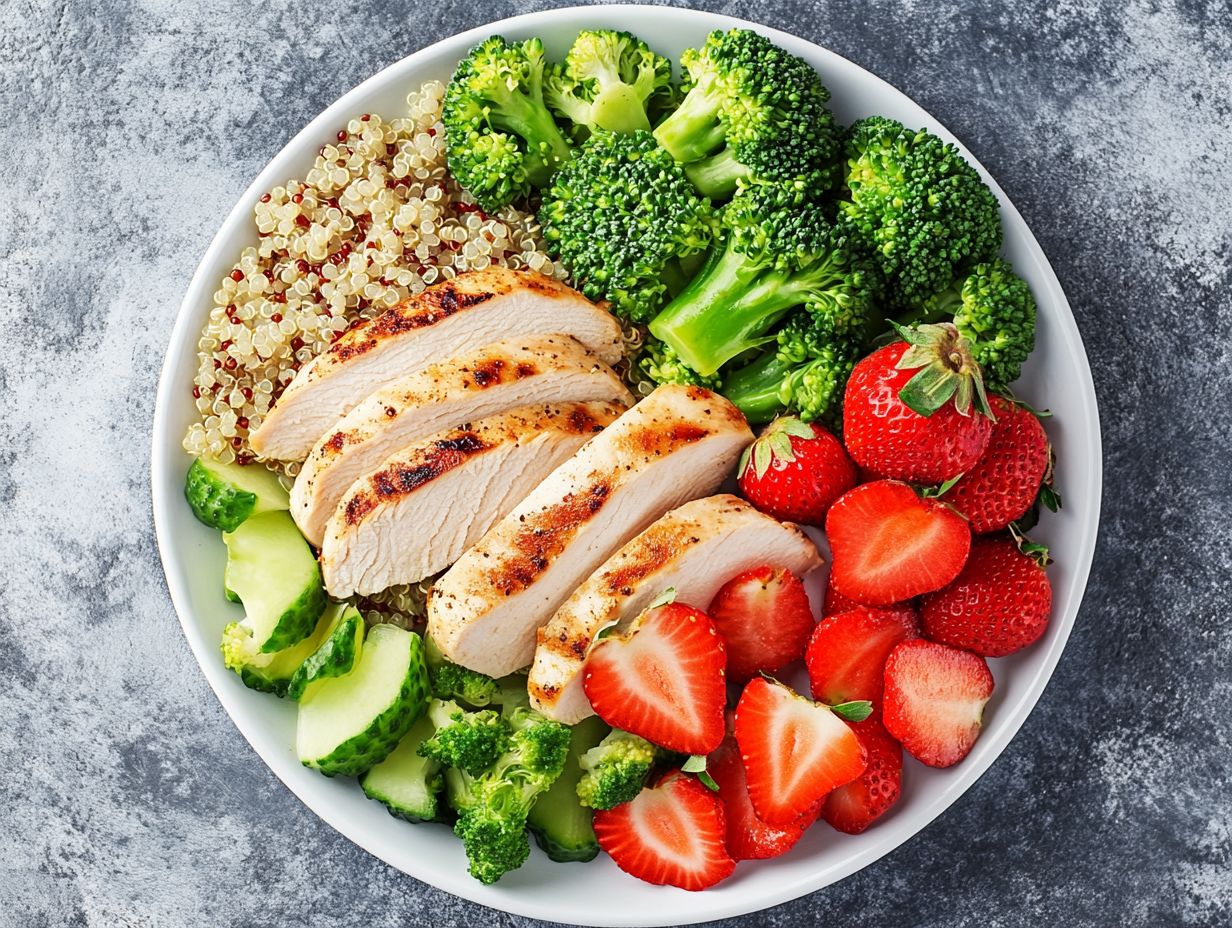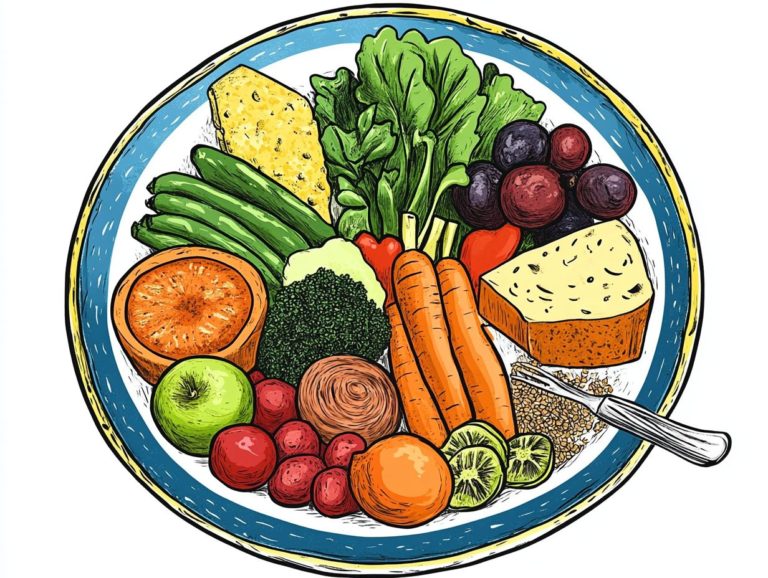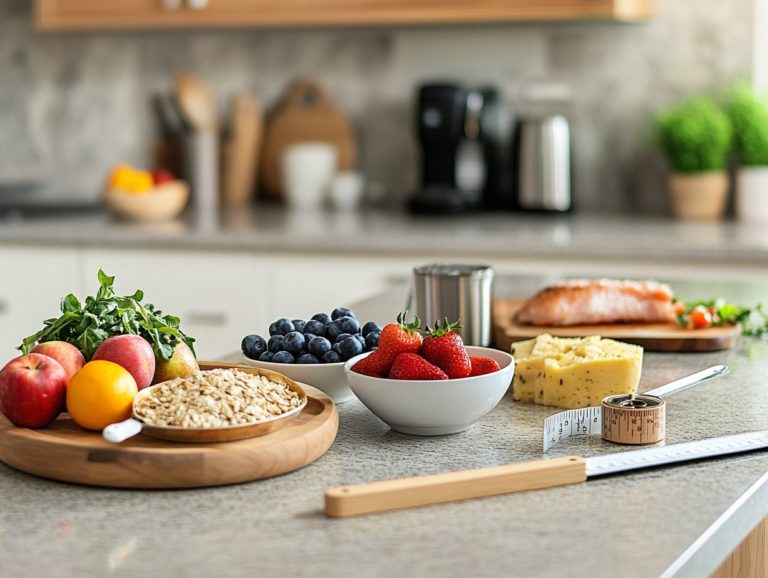How to Create a Balanced Plate
Eating well is vital for your overall health, and one of the most effective ways to accomplish this is by crafting a balanced plate.
Let’s dive in and discover how to make your meals delicious and healthier! This article delves into the importance of a balanced plate, emphasizing essential components like protein, carbohydrates, and vegetables that together form a nutritious diet.
You ll uncover practical tips for portion control and thoughtful food choices, explore healthier alternatives to your favorite dishes, and learn how to uphold balanced eating habits whether at home, dining out, or on the go.
Prepare to elevate your meals and enhance your well-being!
Contents
Key Takeaways:

Eating a balanced plate is your secret to feeling great and staying healthy. A balanced plate consists of protein, carbohydrates, and vegetables in appropriate portions. To maintain this balance, you can learn how to develop a balanced eating routine by practicing portion control and opting for healthy food choices, even while eating out or traveling.
The Importance of a Balanced Plate
The significance of a balanced plate cannot be overstated; it forms the cornerstone of healthy eating habits that enhance your overall well-being and longevity.
By ensuring your meals encompass a variety of food groups, you can attain optimal nutritional value, diminish the risk of chronic diseases like heart disease and cancer, and sustain steady energy levels throughout the day.
Adhering to dietary guidelines, such as those suggested by the Healthy Eating Plate from the Harvard T.H. Chan School of Public Health, encourages the inclusion of essential macronutrients think protein sources, carbohydrates, healthy fats, fruits, and vegetables.
This approach helps you enjoy a variety of foods and satisfying meals.
Why is a Balanced Plate Important for Health?
A balanced plate is essential for your health because it ensures you consume a variety of nutrients vital for optimal bodily function. By incorporating the right mix of proteins, carbohydrates, and fats, you can maintain your energy levels throughout the day essential for productivity and overall well-being.
Dietary guidelines suggest that each meal should include these nutrients in specific proportions, which support metabolism, muscle maintenance, and brain function. For instance, proteins are crucial for cell repair and growth, while carbohydrates provide the necessary fuel for your daily activities.
Healthy fats are equally important, playing a significant role in hormone production and nutrient absorption. By understanding the right mix of nutrients and focusing on whole, nutrient-dense foods, you can create meals that genuinely nourish your body and promote a sustainable, energetic lifestyle.
Components of a Balanced Plate
Imagine a balanced plate as the perfect symphony of food groups, each playing a vital role in nourishing your body and improving your overall health.
The Healthy Eating Plate, created by the Harvard T.H. Chan School of Public Health, elegantly illustrates that your meals should include quality protein sources, healthy fats, whole grains, and a colorful mix of fruits and vegetables.
This harmonious blend offers dietary fiber, essential vitamins, and minerals, all working together to enhance your well-being while stabilizing your blood sugar levels and maintaining your vibrant energy throughout the day.
Protein, Carbohydrates, and Vegetables

In crafting a balanced plate, it s essential for you to grasp the roles of protein sources, carbohydrates, and vegetables as key nutrients that nourish your body.
Incorporating a variety of high-quality proteins think lean meats, eggs, legumes, and dairy can significantly bolster your muscle maintenance and overall health.
Carbohydrates, especially whole grains like quinoa and brown rice, along with starchy vegetables like sweet potatoes, deliver the vital energy you need for daily activities and optimal brain function.
Don t overlook the importance of a colorful array of vegetables, such as spinach, bell peppers, and carrots. Not only do they enhance the flavor of your meals, but they also provide a rich source of vitamins, minerals, and antioxidants.
For example, envision a meal featuring grilled chicken, brown rice, and a delightful medley of steamed vegetables. This combination offers a well-rounded nutritional profile, promoting satiety while supporting your immune system and digestive health.
Start building your balanced plate today for a healthier tomorrow!
Tips for Creating a Balanced Plate
You can simplify the art of making a balanced meal by employing effective meal planning strategies that emphasize appropriate portion sizes and intelligent food choices, ultimately enriching your dietary variety.
Portion Control and Food Choices
Effective portion control is essential in crafting a balanced plate. Mindful food choices guide you to adhere to healthy eating rules seamlessly.
Recognizing the importance of portion sizes in relation to the Healthy Eating Plate can significantly enhance your meal planning and overall well-being.
This framework acts as a visual compass, helping you determine the appropriate amounts of fruits, vegetables, whole grains, and proteins on your plate.
Imagine filling half your plate with vibrant, non-starchy vegetables like broccoli and spinach, reserving a quarter for whole grains such as brown rice or quinoa, and dedicating the remaining quarter to lean proteins like grilled chicken or legumes.
By emphasizing these food choices, you ensure nutritional balance and cultivate healthier eating habits, making portion control a critical part of your daily dietary practices.
Healthy Alternatives for a Balanced Plate
Replacing unhealthy foods with nutritious options is crucial for maintaining a balanced plate. Start today and transform your meals for better health!
This shift can profoundly influence your overall health and enhance the variety in your diet.
Replacing Unhealthy Foods with Nutritious Options

When you replace unhealthy foods, you can significantly elevate your dietary habits, aligning with dietary guidelines while enhancing your overall meal satisfaction.
For instance, consider swapping refined grains like white bread and pasta for whole grain alternatives. Whole grains include foods like brown rice, quinoa, and whole wheat bread. This simple change provides you with more fiber and essential nutrients, ultimately contributing to a healthier digestive system.
If you switch sugary snacks such as candy bars for fruit or nut bars, you introduce natural sweetness along with vital vitamins and minerals. These adjustments boost your energy levels, support better weight management, and help reduce the risk of chronic diseases.
By embracing a broader variety of wholesome foods, you can create a balanced plate that truly nurtures your overall well-being.
Maintaining a Balanced Plate in Different Situations
Keeping your meals balanced can be tricky, but it s totally doable! Maintaining a balanced plate can be challenging whether you’re enjoying a meal at home, dining out, or traveling.
It requires careful meal planning and intentional healthy eating strategies to navigate these situations effectively.
At Home, Eating Out, and Traveling
Whether you’re at home, dining out, or traveling, maintaining healthy eating habits and appropriate portion sizes is vital for sustaining a balanced plate.
To achieve this, plan your meals thoughtfully at home, incorporating a vibrant mix of fruits, vegetables, whole grains, and lean proteins to ensure a well-rounded nutritional profile.
When dining out, making informed choices is key. Consider these strategies:
- Review menus in advance.
- Opt for dishes that feature fresh, seasonal ingredients.
- Share larger portions to help avoid overeating.
When you’re on the go, selecting healthy options like salads with dressing on the side or fruit-based snacks supports a balanced diet and reinforces your commitment to nutritious eating.
Staying mindful in these various settings can significantly enhance your overall well-being.
Frequently Asked Questions
What is a balanced plate?

A balanced plate refers to a meal that contains a healthy balance of all the essential food groups, including protein, carbohydrates, fruits and vegetables, and healthy fats.
Why is it important to create a balanced plate?
Creating a balanced plate ensures that you are getting all the necessary nutrients and energy to function properly and maintain good health. For more detailed guidance, check out Understanding MyPlate: Your Guide to Balanced Meals, which also helps prevent nutrient deficiencies and promotes weight management.
How do I create a balanced plate?
To create a balanced plate, divide it into four sections. Fill 1/2 with vegetables, 1/4 with lean protein (like chicken or beans), and 1/4 with whole grains or starchy vegetables. For those following a vegan diet, you can learn how to create a balanced vegan meal plan. Don’t forget to add a serving of healthy fats!
Choose a variety of foods from each group to ensure a nutritious meal.
Can I still enjoy my favorite foods on a balanced plate?
You can enjoy your favorite foods while maintaining a balanced plate. The key is moderation and portion control. Indulge occasionally, but balance it with healthier choices throughout the day.
How many servings of each food group should I aim for on a balanced plate?
Recommended portion sizes vary based on age, gender, and activity level. As a guideline, aim for 2-3 servings of vegetables, 1-2 servings of fruits, 2-3 servings of lean protein, and 1-2 servings of whole grains.
Are there any other tips for creating a balanced plate?
Here are some exciting tips: Add a splash of color to your plate! Choose whole, unprocessed foods as much as possible. Limit added sugars and unhealthy fats. Finally, drink plenty of water to stay hydrated!






